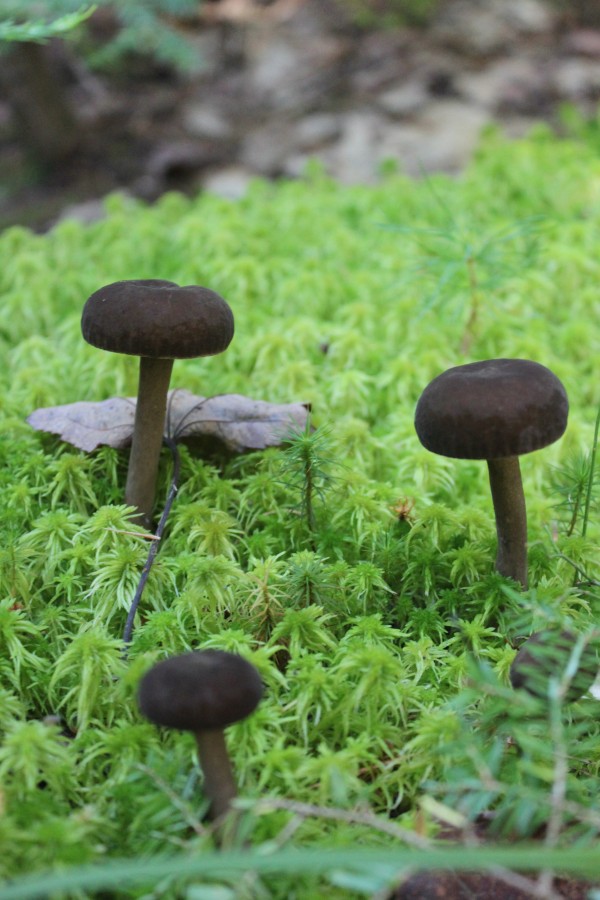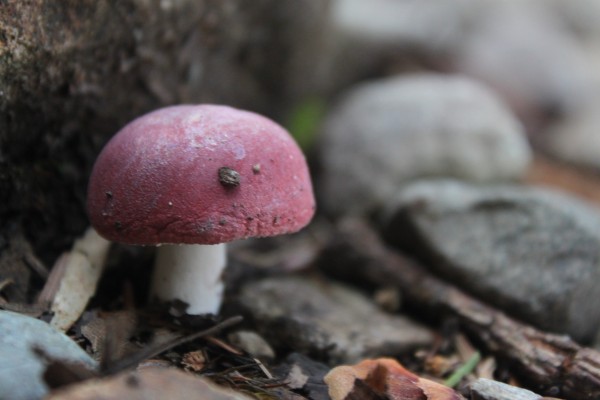
Aislinn Sarnacki | BDN
Brown mushrooms sprout from moss beside a trail in The Mountain trail network in Rome, Maine, on Sept. 20, 2012. Buy Photo

Aislinn Sarnacki | BDN
A red mushroom grows on Big Spencer Mountain near Kokadjo in September 2012. Buy Photo
As summer rolls into fall, bundles of red-orange lobster mushrooms bloom under hemlocks in the Maine woods. Giant puffballs swell to the size of volleyballs and hedgehog mushrooms show their spines.
“You can find mushrooms all year, but 90 percent of the really good edibles are [ripe for harvesting] in the fall,” said mushroom expert Richard Tory, who has been studying mushrooms at his home in Canaan for the past 45 years.
Tory conducts mushroom workshops across the state, and for the past three years, he has presented at the annual mushroom event hosted by Kennebec Messalonskee Trails in Waterville.
This year, despite incessant rain, about 80 people crammed into a small garage at the Quarry Road Recreational Area on Sept. 30 for Tory’s presentation, “The Top 10 Choice Edible Mushrooms.” Most attendees were new to mushroom hunting, and only two people in the crowd had attended the event in previous years.
“I think in general, it’s a curiosity thing,” Tory said. “Wild mushrooms are free food, and everyone has been to the restaurant and seen fancy wild mushrooms. I think people are much more familiar with mushrooms than they were even a few years ago.”
Darren Richards, 36, attended this year’s workshop so he could search for mushrooms with his 5-year-old son on his 26-acre property in Madison.
“Plus, if you get lost in the woods, it’s a good source of nutrition. You never know,” said Richards. “I like mushrooms, but I want to be pretty darn sure before I pick them.”
Waterville’s annual mushroom event began in 2009 and grew for the first three years, from 35 attendees to about 120 people last year. This year, the dreary weather may have deterred a few people from attending, but the rain was actually a good thing for mushrooms, many of which thrive after a late-summer rain.
“This summer was bone-dry,” Tory said. “I haven’t even seen mushrooms that should already be out and by. They haven’t even come out yet.”
So pick up your basket and start hunting.
How to become a mushroom hunter
First things first. Buy a reliable field guide. Tory suggests the “National Audubon Society Field Guide to North American Mushrooms” by Gary H. Lincoff.
In addition to a field guide, it’s important to learn about fungi in general. A helpful online resource is mushrooms4health.com by Maine mycologist Greg Marley. Marley is the author of “Mushrooms for Health; Medicinal Secrets of Northeastern Fungi” and “Chanterelle Dreams, Amanita Nightmares; The Love Lore and Mystique of Mushrooms.” Also, check out mushroom-collecting.com, a site created by David Spahr of Washington, Maine, a forager who is known to some as the “Mushroom Maineiac.”
Then, learn one mushroom at a time.
“It’s like people in maybe a mall. There are lots of people. You don’t know who they are. Then you see a friend, and you can recognize who they are with their back turned,” said Peter Garrett, president of Kennebec Messalonskee Trails and avid mushroom forager.
In other words, the mushrooms you get to know become your “friends” in a forest full of strangers.
Many people start with puffball mushrooms because they’re edible and easily identified. A puffball is typically off-white and shaped like a ball. It can be as small as a marble or as big as a volleyball. And it’s most distinctive characteristic is that it’s barely attached to the ground and has no apparent stem or stalk. To see if it’s edible, cut it in half. The interior should be white and completely solid.
Spend time getting to know the puffball, through a field guide and your senses. Then move on and learn another mushroom.
At the workshop, Tory talked about some of his favorite edible mushrooms: puffball, huitlacoche, shaggy mane, oyster mushroom, chicken mushroom, hedgehog mushroom, bear’s head tooth, chanterelle, black trumpet, king bolete, wine cap stropharia, meadow mushroom, lobster mushroom and white matsutake.
“In general, it’s just like any other hobby,” Tory said. “You don’t want to inundate yourself too quickly. If you just go down that list — and just be curious about what you see out there. See if you can find one or two.”
From hunter to detective
One of the biggest mushroom hunting no-nos is not taking the time to fully identify a mushroom before using it.
“I know it’s a pain in the neck,” said Tory. “But I’ve had someone ask me, ‘What? I’m supposed to delay dinner to do a spore print?’ Yes.”
A spore print is the pattern produced by placing the cap of a mushroom on a piece of paper and allowing the spores to fall. Tory suggests putting a container over the mushroom and leaving it for a few hours. You can use white or black paper, depending on what color you think the spores will best show up against. Most mushroom field guides will have spore print examples to compare against.
It’s not necessary to create a spore print with every mushroom, but it’s a great method to identify the mushrooms you aren’t 100 percent sure about.
Avoid a shroom doom
What’s the worst thing that could happen if you eat a poisonous mushroom in Maine?
“Well, you could die,” said Tory.
The most feared mushroom in Maine is the destroying angel (scientific name, Amanita ocreata). Its body is tall, white and luminous — enchanting. Its stalk is slender and fragile, topped with a flat, circular cap. And circling the stalk is a frilly, white ring.
Feel free to admire it; just don’t eat it. And if you must pick it up, don’t put your fingers in your mouth.
In the Maine woods, this mushroom is fairly common, and its dayglow flesh is also quite flashy and appealing.
So what’s so deadly about it?
The destroying angel contains amatoxins, the most deadly of the many toxins found in mushrooms. Amatoxins are responsible for 80-90 percent of deaths due to mushroom poisonings worldwide. Basically, amatoxins can shut down the liver. There is a 50 percent fatality rate for people poisoned unless they live near a state-of-the-art hospital. Even then, the fatality rate remains at 10 percent.
Fortunately, few people pick and eat wild mushrooms heedlessly. In the past 35 years, an average of two or three people per year die of mushroom poisoning in the U.S., according to the toxicology report of the North American Mycological Association (NAMA).
“There aren’t a great amount [of mushroom species] that are deadly poisonous,” Tory said. “But there are many that will make you sick.”
Many wild edible mushrooms are disagreeable if eaten raw. It’s always smart to cook them, both to release their flavors and convert their proteins into a more usable forms. For information about cooking wild mushrooms, watch Community Television Network’s “Community Kitchens” episode with Marley at video.ctn5.org/mp4/2907.mp4.
Dangers of ‘magic mushrooms’
Beware of any mushroom that falls under the LBM category, “Little Brown Mushrooms.” These mushrooms, which seem to pop up all over the forest, are hard to differentiate and many of them are poisonous and alter the mind.
Psychedelic mushrooms, often referred to as “magic mushrooms,” contain the active ingredient psilocybin, which can cause hallucinations. The mind-altering effects of these mushrooms vary depending on the dosage and user, but usually the effects are sensory (audio, visual and tactile) and emotional, and can lead people to dangerous behavior.
Nearly 200 species of mushrooms are psychedelic, and throughout history, they have been used in a numerous cultures for religious ceremonies and healing.
In the U.S., these mushrooms are illegal. Psilocybin and psilocin are listed as Schedule I drugs and are deemed to have a high potential for abuse. They are not recognized for medicinal use.
In Maine, it is a Class D crime (up to a year in jail and $2,000 fine) and misdemeanor to possess them, and it is a Class C crime (up to 5 years in prison and $5,000 fine) and felony to sell them.
“We see them more with the college group,” said Joseph Burke, a special agent with the Maine Drug Enforcement Agency. “I’ve been doing this for seven years, and I’ve actually been seeing more [psychedelic mushrooms] recently. Ironically enough, I’ve been seeing them more with bath salts users.”
Super Mario sidenote
You know how Mario becomes Super Mario when he eats the magic mushroom? Well that red mushroom with white spots resembles the Amanita musaria, a majestic mushroom that grows in Maine. Commonly known as fly agaric, the Amanita musaria has a bright orange cap (sometimes more yellow or red) with white spots and grows to be quite large. It’s one of the most recognizable mushrooms and easily the most portrayed in pop culture. But don’t let Mario fool you. These mushrooms will not make you grow into an awesomer version of yourself. They are toxic.
Amanita musaria causes hallucinations and is dangerous to consume. While deaths by eating Amanita musaria are rare, they still occur. Its relative is the Amanita ocreata, the deadly destroying angel.
A lesson in foraging etiquette
Mushroom hunting is similar to game hunting in that you should always ask to hunt on someone else’s property, and this includes public lands (some of which have rules against foraging).
“People really do need to mind the ethical pieces of it and try not to ruin it for everyone else,” said Tory, who typically forages on his property.
One reason people might trespass to harvest wild mushrooms is because they’re out to gain a profit, but it’s important to note that selling wild mushrooms to the general public requires state certification through the Wild Harvested Mushroom Certification Program, according to a state law passed on June 29, 2011. Without certification, a forager can only sell their mushrooms to a state certified (and educated) forager. However, the program is not yet up and running, according to Lisa Roy, program manager of the Maine Health Inspection Program. Therefore, the law is not yet being enforced.
Tory doesn’t sell mushrooms. He considers his study of them a hobby, one that has become wound up in so many of his memories. When his children were young, he used to read them all types of books before bedtime, including field guides. It was easy for common mushroom names such as “hen of the woods” and “candy cap” to become characters in a wild fungi world.
“Mushrooms are these weird little things that are just fascinating, not just because they’re edible,” Tory said. “I was sitting on a log one day in my woods. I was kind of tired, looking into space, and I saw these little tiny cuplike things growing on the log and what looked like little eggs in them. These little round cups, a quarter of an inch wide, it turns out they were bird’s nest fungi.”
Even with decades of fungi research under his belt, new mushrooms still pop up and surprise him.
For information about Maine mushrooms, visit the Maine Mycological Association website at mushroomthejournal.com/mma or email them at mmacontact@hotmail.com.
CORRECTION:
An earlier version of this story requires correction. The mushroom commonly known as fly agaric is Amanita musaria, not Amanita moscara.
























